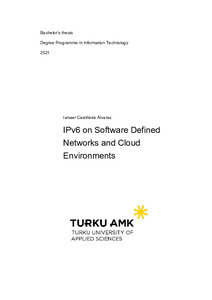IPv6 on Software Defined Networks and Cloud Environments
Castiñeira Alvarez, Ismael (2021)
Castiñeira Alvarez, Ismael
2021
Julkaisun pysyvä osoite on
https://urn.fi/URN:NBN:fi:amk-2021121526039
https://urn.fi/URN:NBN:fi:amk-2021121526039
Tiivistelmä
The purpose of this thesis was to analyse the support and functionality of the Internet Protocol, version 6, on cloud computing environments, and to demonstrate a demo application showing the possible advantages of using only IPv6.
First, the differences of the Internet Protocols were analysed, and a short study on the possible benefits of IPv6 was carried out, sourcing from networking architecture books and the protocol definition documents.
Second, popular cloud providers were evaluated on their level of support of IPv6, and their specific implementation details were tested and documented as well.
Finally, an example application was designed around IPv6-only concepts. The example application demonstrated how it improved on a classic, IPv4-only scenario. The analysis results at the time of writing this thesis were that, developing applications on cloud providers and designing them around IPv6 is not only possible, but offer significant benefits in terms of cost and complexity. Cost saving designs were found to improve flexibility of application architecture, as well.
First, the differences of the Internet Protocols were analysed, and a short study on the possible benefits of IPv6 was carried out, sourcing from networking architecture books and the protocol definition documents.
Second, popular cloud providers were evaluated on their level of support of IPv6, and their specific implementation details were tested and documented as well.
Finally, an example application was designed around IPv6-only concepts. The example application demonstrated how it improved on a classic, IPv4-only scenario. The analysis results at the time of writing this thesis were that, developing applications on cloud providers and designing them around IPv6 is not only possible, but offer significant benefits in terms of cost and complexity. Cost saving designs were found to improve flexibility of application architecture, as well.
